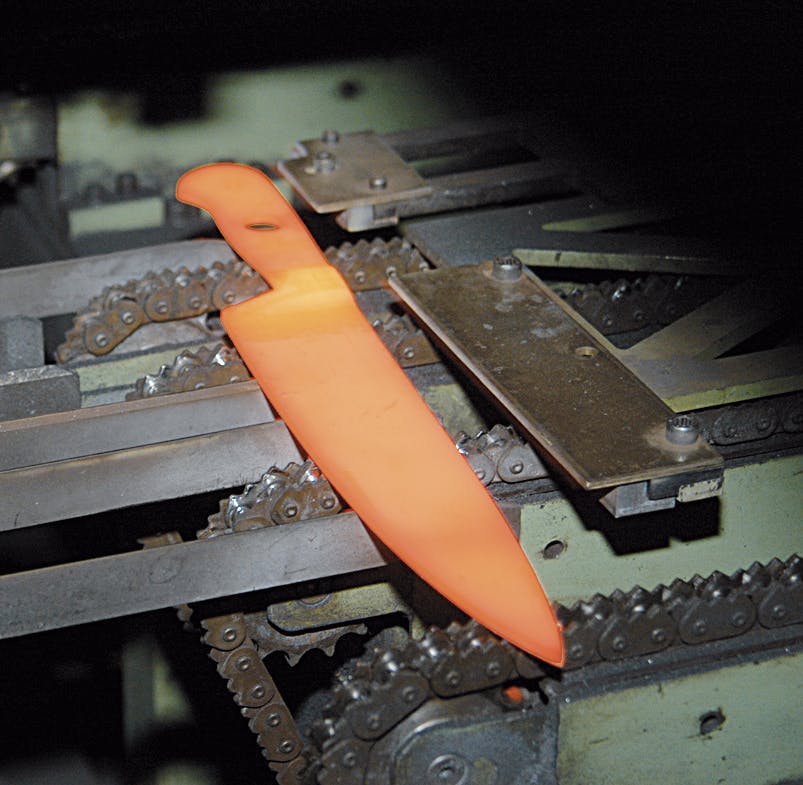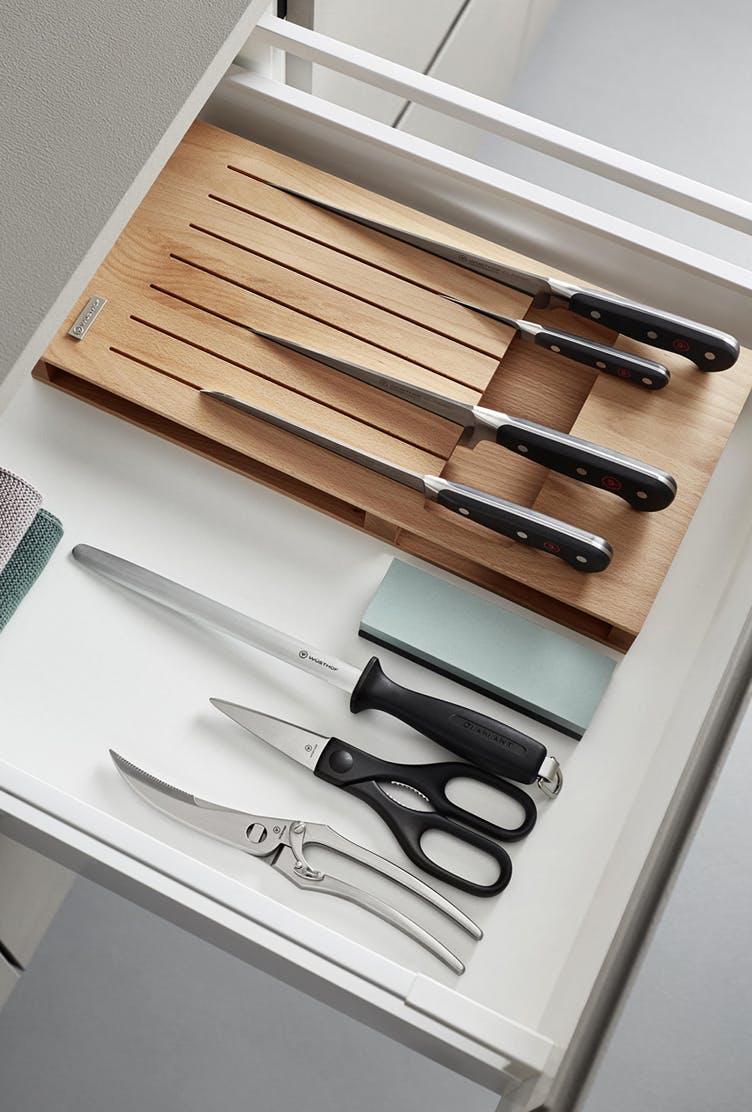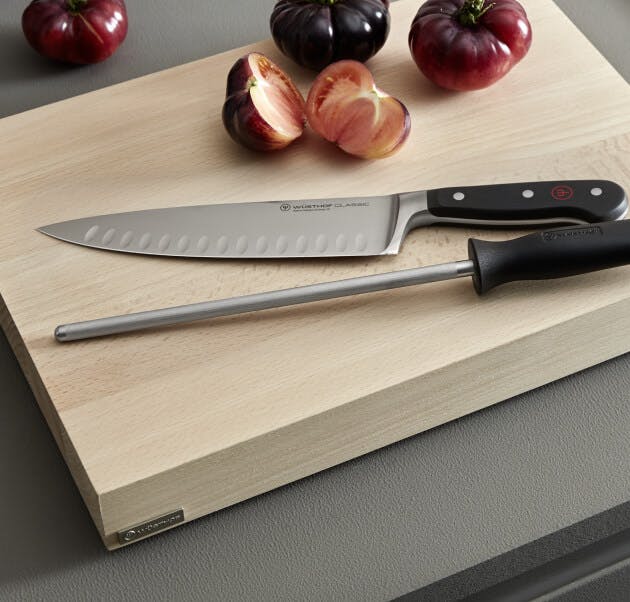Basic knife skills begin with the proper hand positions. Even at the highest level of blade artisanship, using a WÜSTHOF knife safely and efficiently starts with learning how to hold your knife correctly. Follow the advice below, and you’ll be chopping away in no time.
How To Properly Hold a Knife
The correct grip offers better control and balance
We at WÜSTHOF have spent over two hundred years perfecting the details of knifemaking. It probably doesn’t surprise you that we think paying attention to the basics is essential, and one of the most fundamental skills a home cook can have in the kitchen is understanding how to properly hold a knife.
The Pinch Grip
Let’s start with the most standard hold, also known as the pinch grip.
1.Place your dominant hand on the knife handle about an inch from the bolster, the thicker junction between the blade and the handle. Comfortably yet firmly wrap your fingers around the handle without squeezing too tightly. You’re looking for a combination of flexibility and control.
2. Rest your thumb on the flat side of the blade closest to the bolster; it will act as a guide and help stabilize the knife at the same time.
3. Your index finger might curl over the bolster to rest on the flat side of the blade opposite your thumb, though it might not get there naturally — it just depends on your unique hand anatomy. No matter where it lands, your curled index finger will extend slightly to match the thumb, acting as a subtle counterbalance to the opposing hand and further enhancing control.
4. Keep your wrist relaxed and in line with your forearm without bending or torquing. Take a deep breath and maintain a comfortable, easy posture. Like any new skill, it might take a couple of days to embody the correct form before it starts to feel like second nature. We’re confident you can get the gist in no time.
Before we move on, let’s quickly talk about a few incorrect hand positions we commonly observe. One is called the handle grip, which is when the cook curls their fingers and thumb completely around the handle. We understand this instinct — handles are for holding, right? — though this position will stress the wrist and reduce the precision and control of your knife work. If you try to quickly chop, or use a rocking motion on your cutting board, you’ll likely experience your blade skidding or moving sideways. There is one exception here: When your chopping requires an increased force, such as using a cleaver to break down chicken bones, you can use the handle grip to firmly counteract the added momentum on the blade. Only in this case is a handle grip appropriate for maximum control.
Another incorrect way to hold a knife is to extend your index finger straight along the spine of the blade. This is called the finger grip. It not only reduces knife control, but also taxes the extended finger. Now, some specialty chefs, such those traditionally trained for sushi and omakase, might utilize the finger grip on occasion to slice softer ingredients such as fresh salmon or fatty tuna. Yet this is an exception that has to do with specific ingredients, knives, and cutting techniques particular to this work. As a general guide for most home cooks, the pinch grip is safer, more precise, and more comfortable. Luckily, WÜSTHOF’s ergonomic, state-of-the-art handles are designed to emphasize the correct way to hold your knife so there is never any confusion.
A Secure Grip Is A Safe Grip
Now that you know how to correctly hold a knife, the way you slice and dice is about to get a lot more enjoyable. Holding a knife correctly significantly reduces the risk of accidents, cuts, slippage, or mishandling — from our perspective, a secure grip is a safe grip. Greater control over your grip also means increased accuracy over the blade’s movements, translating into controlled, uniform cuts. And finally, mastering correct knife handling techniques allows you to optimize your workflow in the kitchen. Efficient cutting reduces preparation time, enabling you to focus on other aspects of your cooking (like perfecting the best fresh tomato sauce).
Apart from holding your knife correctly, we have a few additional tips and techniques to further improve your knife skills. First, place your cutting board on a stable surface to prevent it from slipping, and ensure the board is at a comfortable height so you can maintain proper posture while slicing. A damp paper towel placed flat underneath the bottom of the cutting board is a common trick to add traction and prevent the cutting board from shifting. Next, position the food on the cutting board by stabilizing it with your non-dominant hand. Whenever you’re chopping, your non-dominant hand should be in “the claw grip,” which keeps your fingertips safe from the path of the blade. To create the claw grip, simply curl the fingers of your non-dominant hand slightly toward your non-dominant palm to create a claw-like shape. Use this claw to secure whatever you are cutting, from onions to celery to baguettes. Of course, remember to hone your knife frequently to maintain its fine edge and ensure that your knifework is as safe as possible. Finally, always clean and dry your knife properly after each use to prolong its lifespan.
Mastering the art of knife handling is a fundamental skill for any home cook or culinary enthusiast. By following the techniques outlined above, you can ensure safety, enhance efficiency, and achieve precise cuts in all the delicious dishes you whip up. Remember, practice and patience are key to developing excellent knife skills. So, embrace the techniques, give them time to marinate, and get ready to unleash your inner chef!










